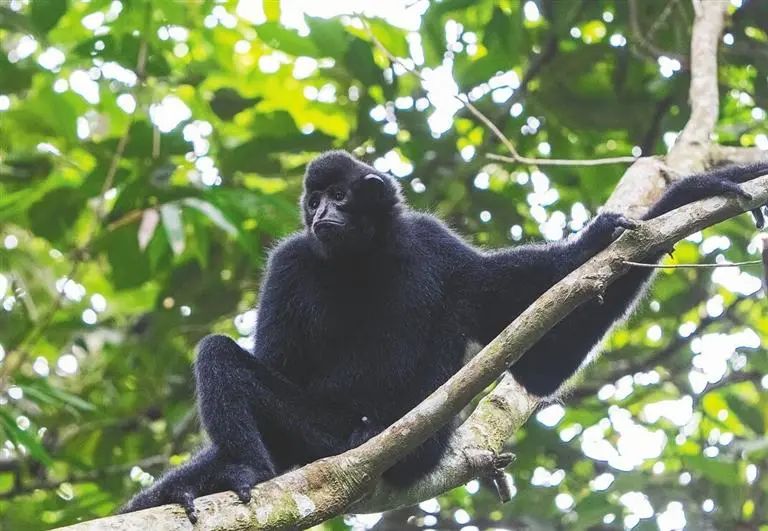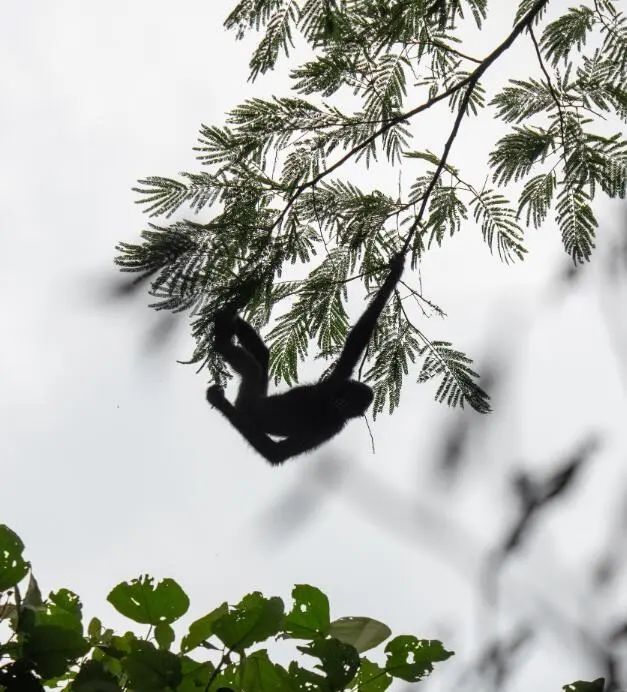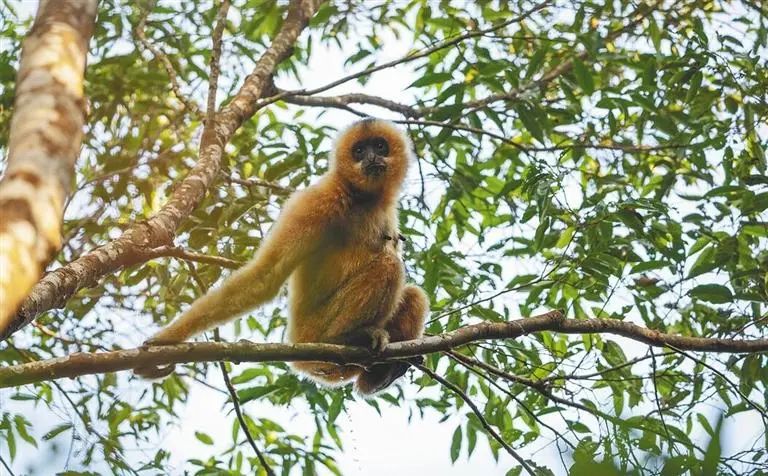Axchanges
Conference forums
Primates Talking Primates: Ape Experts Meet in Hainan
From July 7 to 9, the First Meeting of Partners of the Global Gibbon Network (GGN) was held in Haikou, the capital of southern China's Hainan Province.
Close to 120 domestic and foreign experts and scholars from ten countries and regions and representatives of fifteen international organizations and foundations gathered to discuss creating a long-term conservation mechanism for gibbons. The Hainan Gibbon, a species unique to the meeting's host province, naturally became a focus of the gathering.

The GGN First Meeting of Partners gets underway on July 8. (Photo: Li Tianping / Hainan Daily)
Gibbon conservation relies on broad, in-depth international cooperation
"The Hainan Gibbon is a wonderful species. They have a unique evolutionary lineage and should be properly protected." Susan Cheyne, Vice Chair of the IUCN Species Survival Commission (SSC) Primate Specialist Group Section on Small Apes, believes that the twenty gibbon species globally all deserve to be saved, but that the situation faced by these primate relatives of humankind over the years has often worried her.
At the meeting, Li Baoguo, East Asia Regional Vice Chair of the IUCN SSC Primate Specialist Group, shared a set of survey data: of the more than five hundred known primate species, including gibbons, more than 60% are threatened with extinction, and 75% have experienced population decline.
"If we don't do enough to protect them, perhaps by the end of this century, the only primates left will be humans," said Li.
"We need everyone to get involved." Zhang Xinsheng, former President and Chairman of the IUCN and former Chairperson of UNESCO's Executive Board stressed that gibbon conservation requires the collective wisdom of the international community.
"Gibbons are often found in border areas." Li Jinhua, Chairperson of the Primate Section of the China Zoological Society, said that this fact makes international cooperation on gibbon conservation even more vital.
"Laos' economic development is relatively lagging, limiting the resources available for gibbon conservation." William Bleisch, a researcher at the China Exploration and Research Society (Hong Kong), said that taking this into consideration, the continued support of numerous international organizations has greatly benefited localized gibbon conservation work.
On the border between China and Vietnam can be found the habitat of the Eastern Black-Crested Gibbon (Nomascus nasutus). For many years, China and Vietnam have continued to cooperate across their borders and conduct joint patrols, leading to an increase in the gibbon population. Dindo Campilan, IUCN's Regional Director for Asia, said that this is a successful example of transnational cooperative conservation.
Zhang Xinsheng said that a successful case such as the Hainan Gibbon achieving stable population growth without human intervention deserves attention and analysis, and this is why the First Meeting of Partners of the GGN was held in Hainan.

A male Hainan gibbon belonging to group C rests on a branch in the Bawangling area of Hainan Tropical Rainforest National Park. (Photo: Li Tianping / Hainan Daily)
Restoring and creating a more suitable home for gibbons
The main existential threats faced by gibbons are habitat loss and fragmentation.
There are many reasons that have led to these issues. "They include the fragmentation of nature reserves and the overlapping of human communities and agricultural activities with gibbon habitats." Md. Tarik Kabir, Head of the Western Hoolock Gibbon Conservation Project in Bangladesh, cited Bangladesh, where forests are torn down to make room for Areca palm planting.
Aini Hasanah, a researcher at Terengganu University in Malaysia, added that habitat damage is also caused when consideration is not taken in planning infrastructure, resulting in highways and railways running through forests.
Reducing the impact of human factors has become a top priority for countries in carrying out gibbon conservation.
But that doesn't mean humans should just leave the gibbons to their fate, at least for now. "We need to intervene to help gibbons with habitat restoration," said Dilip Chetry, Vice President & Head of Primate Research and Conservation Division of Aaranyak - a biodiversity research and conversation institution in India.
To this end, Malaysia has set up ecological corridors for local gibbons to link up their fragmented habitat. During this process, said Aini Hasanah, they focused on restoring old, damaged habitats and began experimenting with creating new habitats for gibbons.
Referring specifically to Hainan gibbons, Fan Pengfei, Vice Chairperson of the Primate Section of the China Zoological Society and professor at Sun Yat-sen University's School of Life Sciences, believes that the quality of their existing habitats is fair, and even can support the survival of more gibbon family groups.

A Hainan gibbon climbing on a tree branch. (Photo: Li Tianping / Hainan Daily)
"Through long-term field monitoring, we found that tropical lowland rainforests below 800 meters and naturally regenerated pine forests can become gibbon habitats." Long Wenxing, a professor at Hainan University, said.
Xu Han, a researcher at the Chinese Academy of Forestry's Institute of Tropical Forestry, believes that areas of tropical rainforest disturbed by human activity have the potential to recover by themselves, and, with a little human intervention, can be turned into candidate habitats for gibbons.
"At present, we have drawn up a preliminary list of hundreds of native tree species that can be used for ecological corridor planting and lowland rainforest restoration. We plan to attract gibbons to migrate and spread to potential habitats through these ecological corridors." Xu Han said.
Multidisciplinary support urgently needed in gibbon research
Much has been done when it comes to researching gibbons' habitats and what to do about them. When it comes to the gibbons themselves, however, there remain many unanswered questions waiting for researchers to get stuck into.
For example, in recent years, researchers have been using sound equipment and digital technology to establish a Hainan Gibbon "sound archive" in order to "understand" their joys, sorrows, and other emotional expressions. "At present, we have achieved 95% accuracy in identifying known individuals," revealed Fan Pengfei.

A female gibbon feeding atop a tree branch in the Bawangling area of Hainan Tropical Rainforest National Park. (Photo: Li Tianping / Hainan Daily)
"Are some of the experiences and practices of Giant Panda conservation also worth learning from?" proposed Huang Jinggui, a professor at Hainan University's School of Economics. This was echoed by Susan Cheyne: "Why is the conservation of giant pandas so successful? The methodology and logic behind it are worth thinking about."
The meeting was attended by botanists, ornithologists, and economists, demonstrating that gibbon conservation is a multidisciplinary undertaking. It also confirms the complexity of the issue, which requires the joint efforts of multiple parties to solve problems at a variety of levels.
Public participation in gibbon conservation: beneficial for all...if done right
"The topic of gibbon conservation seems to be limited to certain circles and has not received enough attention among the general public." Huang Jinggui warned against this phenomenon.
"One of the most important things we do is to educate the public about the gibbons and increase their knowledge and understanding," said Dilip Chetry.
How can local communities be mobilized to participate in conservation efforts? Rahayu (Ayu) Oktaviani, Co-founder and Director of KIARA (Nusantara Natural Ecosystem Conservation Foundation) in Indonesia, believes that, first, communities should benefit from participating in the conservation process.
"A great way to do this is to develop ecotourism and let them provide services to tourists." According to Ayu, this can be a win-win situation: "The community gains and the public gains a better understanding of gibbon conservation during their visit."
A question that cannot be ignored, however, is whether the development of ecotourism activities will cause further disturbance to gibbons.
William Bleisch shared an example of a gibbon habitat in northern Laos where seven tree houses roughly forty meters above the ground were erected, enabling visitors to experience the life of Tarzan (the Ape Man) via cableways in the canopy. The local community provided related tourism products and services.
"This tourism project has been open for many years." After monitoring the situation, Bleisch found that instead of being disturbed, these gibbons enjoy moving around the tree houses, "which may mean that the existence and use of the tree houses actually aid gibbon conservation."
But other experts raised concerns: Will human contact with gibbons lead to the transmission of diseases or other unforeseen dangers?
"We encourage the public to go see the gibbons to better raise conservation awareness within society." Susan Cheyne stressed that all tourism activities involving viewing the gibbons should be guided by science.

